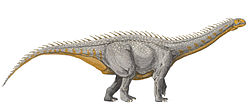| Abdarainurus Temporal range: Late Cretaceous | |
|---|---|
 | |
| Skeletal reconstruction with known material in white | |
| Scientific classification | |
| Domain: | Eukaryota |
| Kingdom: | Animalia |
| Phylum: | Chordata |
| Clade: | Dinosauria |
| Clade: | Saurischia |
| Clade: | † Sauropodomorpha |
| Clade: | † Sauropoda |
| Clade: | † Macronaria |
| Clade: | † Titanosauria |
| Genus: | † Abdarainurus Averianov & Lopatin, 2020 |
| Type species | |
| †Abdarainurus barsboldi Averianov & Lopatin, 2020 | |
Abdarainurus (meaning "Abdrant Nuru tail" after the holotype locality) is a genus of titanosaur dinosaur from the Alagteeg Formation in Mongolia. The type and only species is A. barsboldi. Currently seen as an indeterminate titanosaur, it may represent a previously unknown lineage of Asian macronarians. [1] Abdarainurus is not known from many remains; it is only known from eight front tail vertebrae and a middle tail vertebra and several chevrons.












